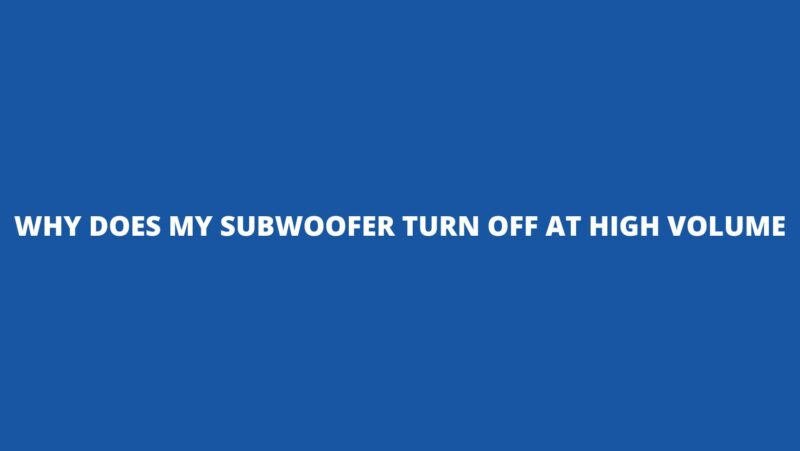The world of audio enthusiasts and music aficionados is no stranger to the allure of a powerful subwoofer, capable of unleashing deep, resonant bass that enriches our auditory experiences. However, a perplexing scenario often disrupts the harmony: subwoofers turning off at high volume. This phenomenon, which seems counterintuitive, has roots in a complex interplay of factors, including power limitations, thermal protection mechanisms, and the intricacies of audio systems. In this article, we delve into the various reasons behind subwoofers shutting off when pushed to their limits and provide insights into troubleshooting techniques to overcome this conundrum.
Power Limitations and Current Draw
At the heart of the matter lies the concept of power limitations. Subwoofers, like any electrical device, have a finite power threshold beyond which their performance may be compromised. When subwoofers operate at high volumes, they draw a significant amount of current to produce deep bass frequencies. If the subwoofer and the audio system are not adequately powered, the sudden surge in current demand can lead to voltage drops or fluctuations in the power supply.
To address this, ensure that your subwoofer is connected to a power source that can deliver the required current without voltage drops. Using a dedicated power outlet or a surge protector with sufficient power capacity can help stabilize the power supply, preventing unexpected shutdowns.
Thermal Protection Mechanisms
Subwoofers are designed to withstand prolonged use, but extended operation at high volumes generates heat that can affect internal components. To safeguard against overheating and potential damage, many subwoofers are equipped with thermal protection mechanisms. When the temperature inside the subwoofer enclosure rises to a certain threshold, these mechanisms automatically shut down the subwoofer to prevent harm.
To mitigate this, ensure that your subwoofer is properly ventilated and not enclosed in a tight space that restricts airflow. Avoid placing objects on top of the subwoofer that could obstruct heat dissipation. Additionally, consider periodically lowering the volume to allow the subwoofer to cool down during intense listening sessions.
Amplifier Clipping and Distortion
At high volume levels, the amplifier within the subwoofer might encounter a phenomenon known as “clipping.” Clipping occurs when the amplifier is pushed beyond its limits, causing it to deliver distorted signals to the subwoofer’s driver. This distortion not only compromises audio quality but also increases the stress on the driver and amplifier components.
To prevent amplifier clipping, ensure that the subwoofer’s gain and volume settings are properly calibrated. Avoid pushing the volume to extremes where distortion becomes evident. Properly calibrated settings will help maintain audio quality while reducing the risk of thermal overload or damage.
Speaker Impedance and Amplifier Matching
Mismatched impedance between the subwoofer and the amplifier can also lead to unexpected shutdowns. Impedance mismatch can cause the amplifier to work harder than intended, resulting in overheating or triggering protection mechanisms.
Verify that the subwoofer’s impedance rating matches the amplifier’s specifications. If you’re uncertain about these technical details, consulting the manufacturer’s guidelines or seeking expert advice can prevent impedance-related issues.
Cable and Connection Issues
Weak or faulty connections between the subwoofer, amplifier, and source can contribute to unexpected shutdowns. Poor connections can lead to increased resistance and voltage drops, causing the subwoofer to shut off due to insufficient power supply.
Inspect all cables and connections for signs of wear or damage. Ensure that connections are secure and free from debris that could affect conductivity. Using high-quality, properly rated cables can help maintain reliable connections.
Audio Source Quality
The quality of the audio source itself can play a role in triggering subwoofer shutdowns. Low-quality recordings or improperly encoded audio files might contain extremely low or distorted frequencies that cause the subwoofer to work excessively hard, leading to overheating or protection mechanisms kicking in.
Ensure that you’re playing high-quality audio from reputable sources. Avoid using bass-boosted or equalized audio tracks that could strain the subwoofer unnecessarily.
Conclusion
The puzzle of subwoofers turning off at high volume is an intricate one, woven from a tapestry of power limitations, thermal protection mechanisms, and technical intricacies. By understanding these factors and employing effective troubleshooting strategies, audio enthusiasts can navigate this challenge and enjoy uninterrupted, immersive sound experiences.
To address issues related to power limitations, ensure stable power supply and proper grounding. Prevent overheating by providing adequate ventilation and being mindful of extended high-volume usage. Properly calibrate gain settings to avoid amplifier clipping and distortion, and verify impedance compatibility between the subwoofer and amplifier.
In the world of audio, achieving the perfect balance between power, performance, and protection requires a holistic approach. By mastering the art of technical understanding and optimization, enthusiasts can revel in the captivating allure of deep bass without the interruption of unexpected shutdowns.


